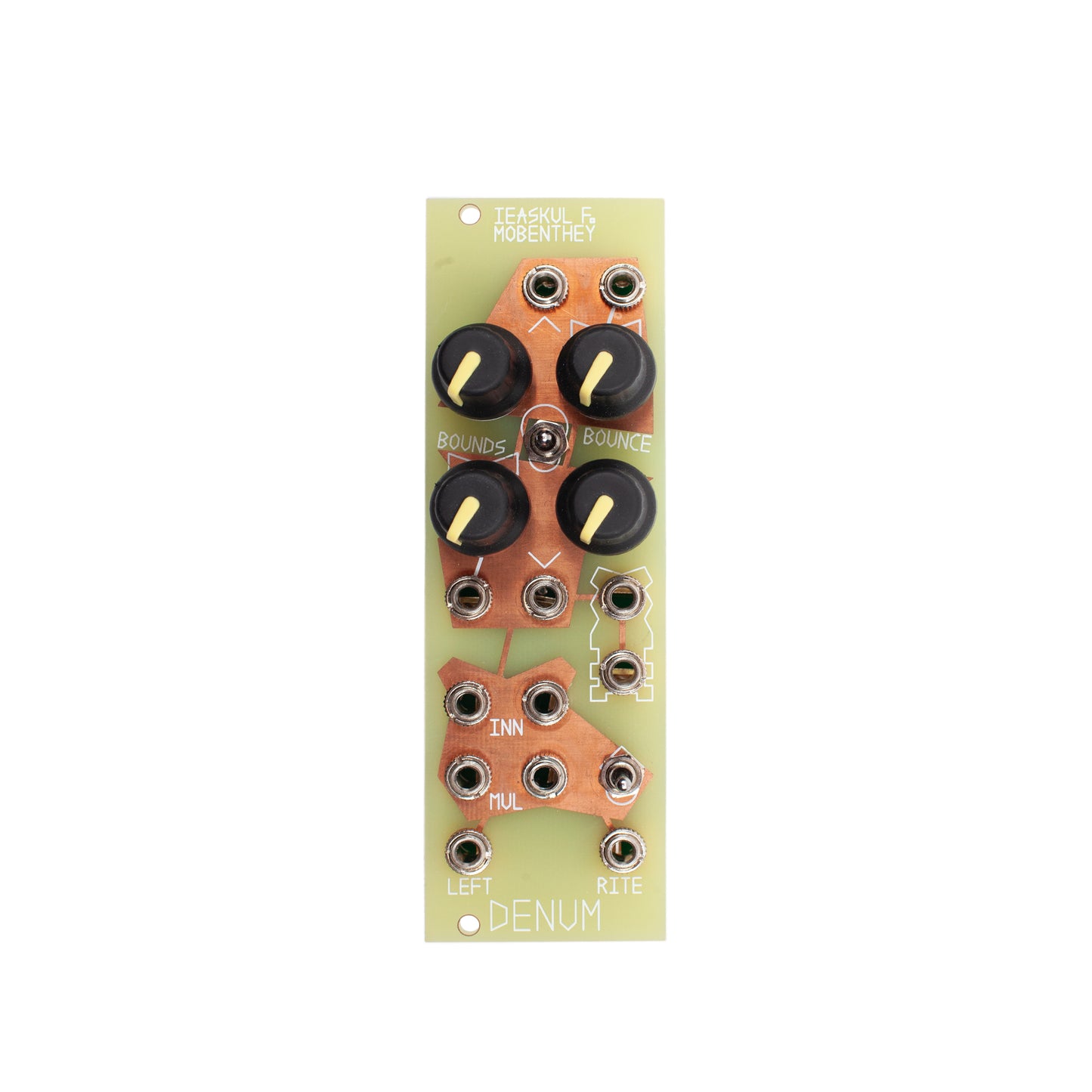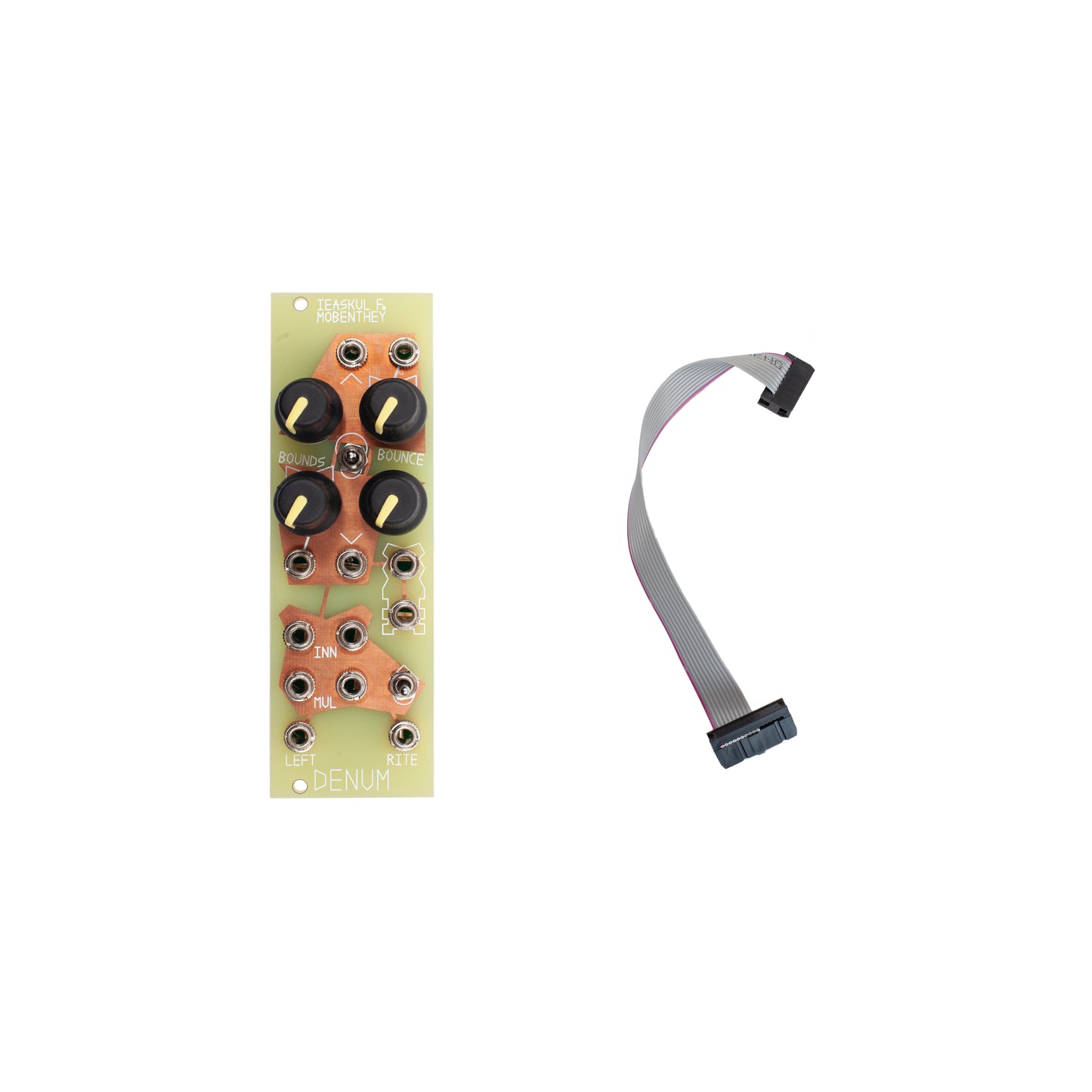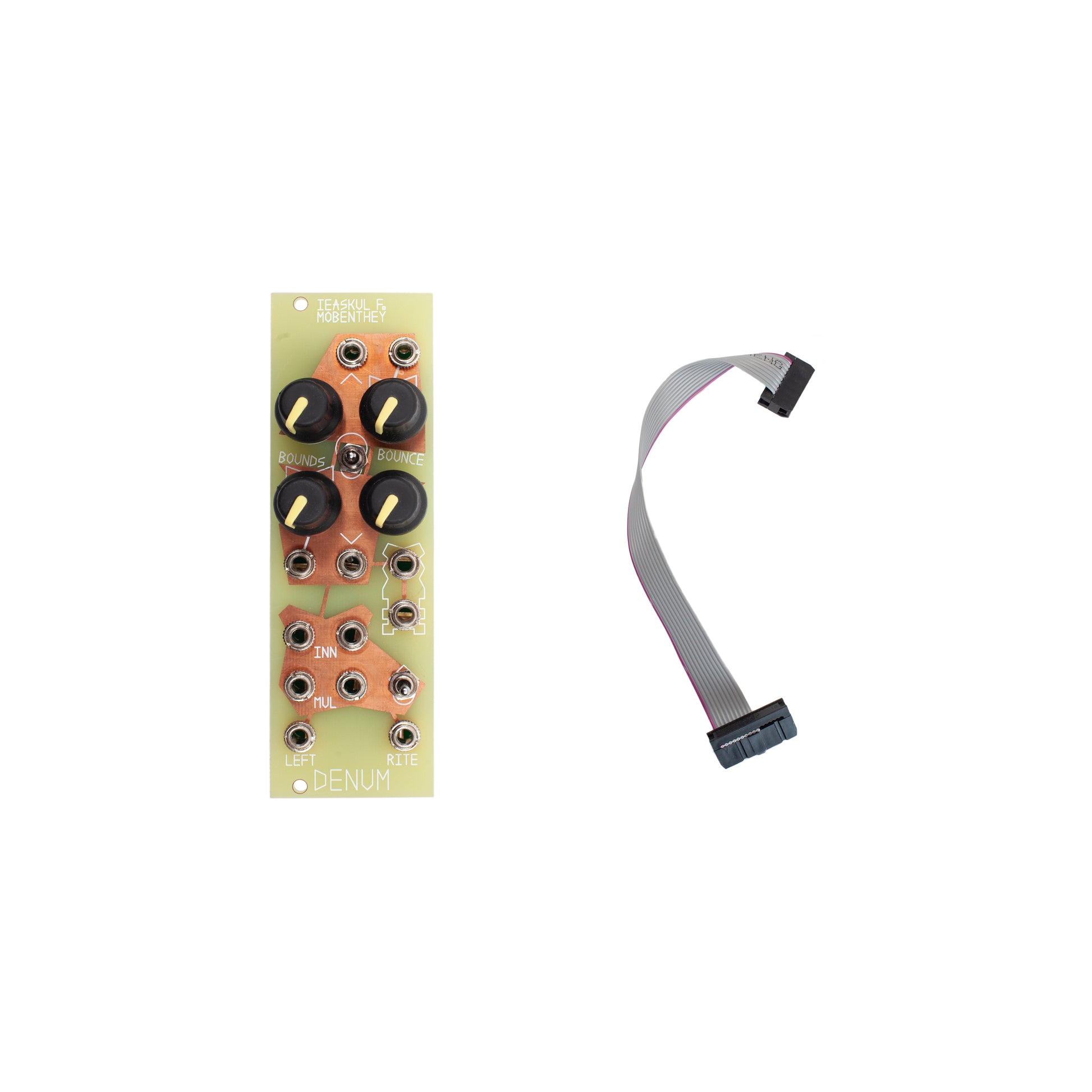Ieaskul F. Mobenthey
Denum
Denum
Couldn't load pickup availability
4-12 weeks lead time
Eurorack format from Ciat-Lonbarde
It’s an Bounds/Bounce Oscillator and a stereo VCA — what else could you ask for in one 8 hp module? Maybe inputs accepting normal eurorack inputs and low impedance things like contact mics, and instruments. Is this Magic? No it’s Mobenthey.
Text by Peter Blasser
The Denum module is essentially a bounds/bounce oscillator. It has the “triangle core” circuitry used in many oscillators, but it adds a correlated bounds modulation, according to the concept (see below). Here, bounds and bounce are each given equal treatment, with separate linear and exponential controls and inputs. In addition, this module has a fully featured bi-polar VCA with complimentary inputs, to get you quickly going sending “bb-objets” out the left and right channels.
Denum is an 8HP Eurorack module that runs on +12 and -12 volts. Attach power connector positive to “+” and negative to “-”. Failure to follow proper power polarity will result in instant destruction of unit.
Looking at the front panel of Denum, note that inputs are marked by copper fill. There are three main sections: bounce, bounds, and the VCA. Bounce is above bounds to emphasize the numerator/denominator relationship of the two. Each of the two has exactly the same inputs and knobs. The “basis” knob sets the base rate or position for bounds. There is a linear control input, marked by a a caret. Linear modulation is an alternative input for pre-enveloped audio, since it has no attenuverter. However, the exponential control input is tied to an attenuverter, marked by a characteristic bow-tie. An attenuverter works like this: at noon the modulations are nulled out, they have no effect; clockwise from there they increase in intensity, with positive input meaning “more”; to the counter-clockwise direction, modulations increase as well, but with negative input meaning “more”. This knob is essential to controlling how much, and in which direction, your modulations apply.
Between the bounds and bounce areas, there is a range switch. When in middle position, Denum runs at a standard audio rate. Pointing downward is a low audio rate, and pointing upwards is a definite CV, lowest rate.
The triangle output speaks the position of the waveform in voltage, and square expresses the frequency in terms of negative and positive 10 volts.
The triangle output is bussed into the left and right audio inputs of the VCA, at bottom. Either can be swapped out for external audio energies, via the “left, right signal inserts”. The “left, right VCA inputs” are for controlling the amplitude of the signals, with either a linear or exponential mapping. If the left input is greater than right, sound goes out the “left out”. If right is greater than left, sound goes out the “right out”. The voltage amount of difference maps to loudness in these channels. The “linear, expo switch” chooses linear when cocked up, as marked by a caret, and exponential when cocked down, as marked by a rounded form. There is an optional mute when the switch is in the middle.
About Bounds/Bounce
In porting triangle oscillators to the digital realm, I noticed that it was just as easy to modulate their speed as it was to change their boundaries. This is because triangle oscillators are a simple mechanism: go up until upper bound is reached, then go down until lower bound is reached, and repeat ad infinitum. Meditating on this idea, it soon became apparent that the two modulations, bounds and bounce, are exactly complimentary in their effect on pitch; as bounds gets “more” the frequency gets lower, and as bounce gets “more” the frequency gets higher. Furthermore, pitches can thus be expressed in ratio form, like the musical tuning systems of just intonation; bounce numerates and bounds denominate. On a computer it became an aesthetic imperative to program using only the “int” number set, forming an alternative to the “float” number system. Porting the concept back to analog electronics does not preserve the integers, of course, because here we are dealing with flows of gray again, but it preserves intact the modal philosophy of “bounds/bounce”. Thus most triangle oscillators are only “bounce modulating”, but here we have a new sort of “bounds modulation,” for the palette, that acts in a different way from the typical. To illustrate, imagine modulating the speed of a triangle wave; you can change it at any moment in time, in continuous intervals. Bounds, however, can only be modulated at the moment they are tested, at top and bottom. Modulating bounds can sometimes have the sound of “sync lock” and the associated undertone series heard in primitive electronic “555” circuits. However, the abstraction of bounds modulation provides for more subtle, inharmonic possibilities and combination with traditional bounce modulation gives the end user a confident stab into the realm of infinite possibilities.
Difference from Swoop
In all bounds/bounce modules, oscillation has a place in space, through positive feedback, as well as place in time, with negative feedback. It is the relationship of the two that determines its frequency. Swoop and Denum both manifest this concept, but you could say that Swoop is more for controlling, enveloping events, and Denum is more for continuous waveforms, although Ieaskul incites you to think differently from this modus.
The main thing to remember with Denum is that modulations are mapped entirely symmetrically across bounds and bounce. Both have a linear input and exponential input. We all know what exponential bounce is; the source of one volts per octave scaling achieved by adjusting the attenuverter just so. But because it goes from top down, how can exponential bounds control “work”? Well, it turns out to be just as robust; no frequency band is over-played across all input voltages. To describe it: low voltages result in infinitely high frequencies, and going down you need to go slowly because it is transitioning from “very high” down to a normal range, and there are a lot of frequencies to cross! And then the transfer function can start going faster because the effect on frequency is less in lower frequencies. It's hard to understand in analog, so let's try thinking about it in numbers, as an emulation. Imagine using just intonation, with ratios to specify frequency. 1 to 2 is an octave up. 1 to 1⁄2 is an octave down: big changes. But 2 to 3 is the same distance as 1⁄2 to 1/3: a musical fifth. Extend this system out and you see that everything gets tighter whether going from 32 to 33 or 1/32 to 1/33. That is why exponential control can and “should” be applied to both bounds and bounce.
Noting that the Swoop module allows you to control the top and bottom bounds separately, Denum does not take raw inputs for them, but converts control voltages in a manner complimentary to bounce; it is the tonal effect of this complementarity that distinguishes it from Swoop. Turning the “bounce basis” knob up, as would be expected, brings the pitch up. Turning the “bounds basis” knob up, on the other hand, brings pitch down. It also manifests a change in the amplitude of the triangle wave, such that high sounds are quieter and low sounds are louder, thus mimicking the primitive effect of a low-pass filter and the general aesthetic concern for loud bass and un-ear-piercing highs. Rest assured, however, that this is not an “aesthetic” design dongle, but a strict adherence to the new-materialism dictum of letting the circuit speak.




